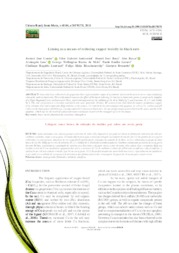Liming as a means of reducing copper toxicity in black oats.
Liming as a means of reducing copper toxicity in black oats.
Author(s): COMIN, J. J.; AMBROSINI, V. G.; ROSA, D. J.; BASSO, A.; LOSS, A.; MELO, G. W. B. de; LOVATO, P. E.; LORENZI, C. R.; RICACHENEVSKY, F. K.; BRUNETTO, G.
Summary: Soils which are cultivated with grapevines have high available copper (Cu) content, which can be toxic to cover crops cohabiting vineyards, such as black oats. This study aimed to assess the effect of liming in reducing Cu toxicity in black oats grown in sandy soils. Samples of a Typic Hapludalf were collected at 0-20cm, dried and subjected to the addition of Cu (0 to 50Mg kg-1) and limestone (0, 1.5, and 3.0Mg ha-1). The soil was placed in a rhizobox and black oats were grown for 30 days. We assessed root and shoot dry matter production, copper (Cu), calcium (Ca) and magnesium (Mg) contents in the tissues; Cu content in the root symplast and apoplast, as well as Cu, carbon and pH values in the rhizosphere and bulk soil. Liming reduced Cu toxicity in black oats. Cu was preferentially accumulated in the roots, mostly in the apoplast, which may be the result of a plant tolerance mechanism to prevent the transport of Cu to the shoots. Key words: heavy metal, phytotoxicity, limestone, rhizosphere. RESUMO: Solos cultivados com videiras possuem alto teor de cobre (Cu) disponível, que pode ser tóxico às plantas de cobertura do solo que coabitam vinhedos, como a aveia preta. O estudo objetivou avaliar o efeito da calagem na redução da toxidez por Cu em plantas de aveia preta cultivadas em solo arenoso. Amostras de um Argissolo Vermelho foram coletadas na camada de 0-20cm, secas e submetidas à adição de duas doses de Cu (0 e 50Mg kg-1) e três de calcário (0, 1,5 e 3,0Mg ha-1). O solo foi acondicionado em rhizobox e submetido ao cultivo de aveia preta durante 30 dias. Avaliaram-se a produção de matéria seca das raízes e da parte aérea, o teor de cobre (Cu), cálcio (Ca) e magnésio (Mg) nos tecidos; o teor de Cu no simplasto e apoplasto das raízes, e os teores de Cu, de carbono e valores de pH no solo rizosférico e não rizosférico. A aplicação de calcário reduziu a toxidez por Cu na aveia preta. O Cu foi preferencialmente acumulado nas raízes, especialmente no apoplasto, o que pode ser resultado de mecanismo de tolerância das plantas para evitar o transporte de parte do elemento para a parte aérea. Palavras-chave: metal pesado, fitotoxidez, calcário, rizosfera.
Publication year: 2018
Types of publication: Journal article
Unit: Embrapa Grape & Wine
Keywords: Calcário, Cobre, Fitotoxidez, Heavy metal, Limestone, Metal Pesado, Phytotoxicity, Rhizosphere, Rizosfera, Solo, Videira
Observation
Some of Embrapa's publications are published as ePub files. To read them, use or download one of the following free software options to your computer or mobile device. Android: Google Play Books; IOS: iBooks; Windows and Linux: Calibre.
Access other publications
Access the Agricultural Research Database (BDPA) to consult Embrapa's full library collection and records.
Visit Embrapa Bookstore to purchase books and other publications sold by Embrapa.

